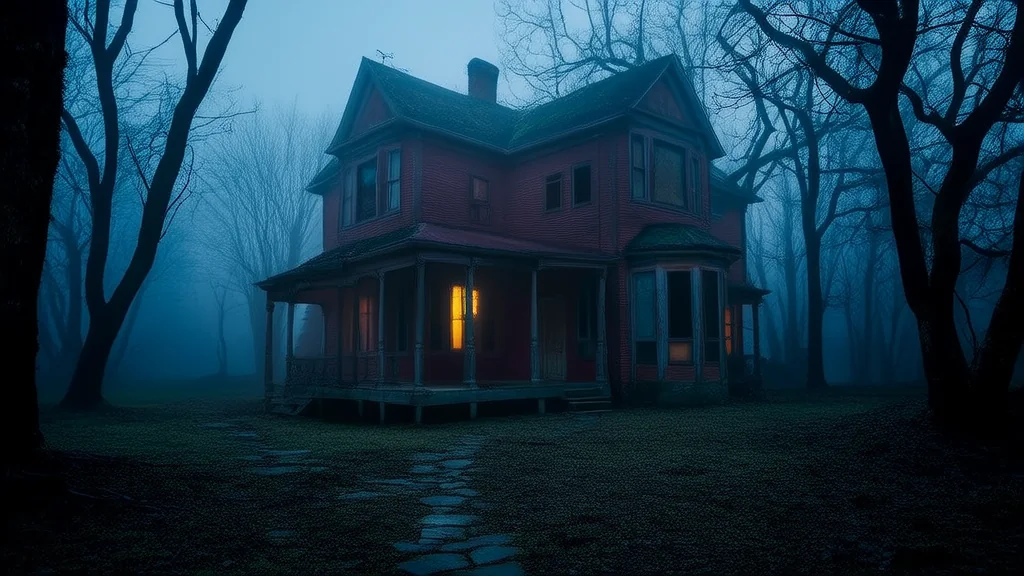🔮 Weird Tales & Urban Legends
The Whispering House in the Fog of Hollowbrook

In the quiet town of Hollowbrook, where the fog clung to the ground like a living thing and the trees whispered secrets only the wind could understand, there was a place no one dared to speak of. It was called the Red House, though it had long since lost its original color. Paint peeled from its walls in jagged strips, revealing a dull, rusted hue beneath. The windows were dark, always dark, even when the sun was high in the sky.
No one knew who built the Red House or why it stood alone on the edge of the woods. Some said it was a research facility from the 1950s, others claimed it was a mental asylum that had been abandoned after a fire. But the townspeople never spoke of it, not even in hushed tones. They just avoided the road that led to it, as if the mere act of looking at it might summon something worse than death.
One spring morning, a young journalist named Clara Whitmore arrived in Hollowbrook. She had heard rumors about the Red House while researching an old classified government file she’d found online. The file mentioned a project code-named "Echelon," but the details were redacted. What little she could read hinted at strange experiments involving human consciousness and time anomalies. Intrigued, she decided to visit the town and see what she could uncover.
She asked around, but the locals were uncooperative. The shopkeeper at the general store refused to meet her eyes. The librarian mumbled something about “old stories” and quickly closed her book. Even the local priest, a kind-faced man with a voice like gravel, warned her not to go near the Red House. “Some things,” he said, “are meant to stay buried.”
Undeterred, Clara set out on foot toward the house at dusk. The air grew colder as she walked, and the trees seemed to lean inward, creating a tunnel of shadows. When she finally reached the Red House, she found the gate slightly ajar, as if someone had left it open for her.
Inside, the silence was oppressive. The floorboards creaked under her feet, and dust motes swirled in the dim light filtering through the broken windows. She moved cautiously, her flashlight beam cutting through the gloom. In the living room, she found old medical charts pinned to the wall, covered in strange symbols and notes written in a language she didn’t recognize. On the table sat a single, rusted key and a journal with pages filled with erratic handwriting.
As she turned the pages, the words began to make sense. The journal belonged to a Dr. Elias Vorn, a scientist who had worked on Echelon. He wrote about experiments that involved sending people into a state of suspended time, where they would experience moments that weren’t real—memories that hadn’t happened yet. He described how some subjects returned changed, speaking in riddles, claiming to have seen “the other side of the clock.”
Clara’s breath caught as she read a final entry: *“The door is not locked. It never was.”*
A cold breeze swept through the house, and the lights flickered. She turned, and for a moment, she saw a figure standing in the doorway. It wasn’t human. Its form shifted, like smoke caught in a storm. Then it was gone.
She ran out of the house, heart pounding, and didn’t stop until she reached the town square. No one was there. The streets were empty, the buildings silent. As she looked back toward the forest, she noticed that the Red House was gone. Not destroyed, not moved—but simply… not there.
In the days that followed, Clara tried to find the house again, but it was as if it had never existed. The townspeople acted as if they had never heard of it. She kept the journal and the key, but the more she studied them, the more she felt as if they were watching her.
And sometimes, in the stillness of night, she would hear a soft ticking, like a clock that had forgotten how to count.
Published on en
🔗
Related Sites
- AI Blog — AI trends and tech news